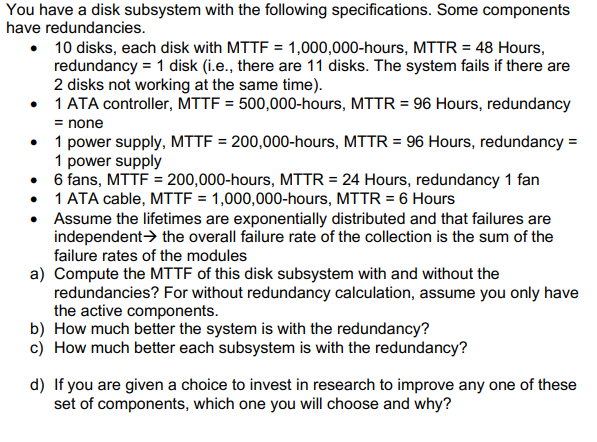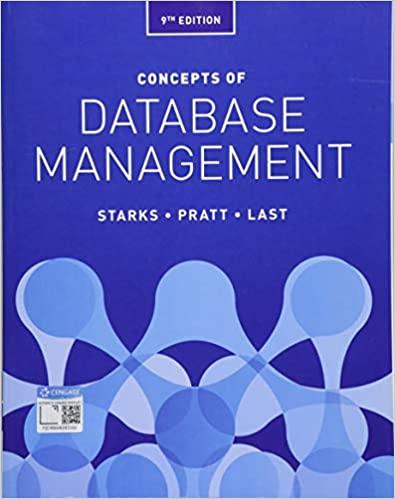
You have a disk subsystem with the following specifications. Some components have redundancies. 10 disks, each disk with MTTF = 1,000,000-hours, MTTR = 48 Hours, redundancy = 1 disk (i.e., there are 11 disks. The system fails if there are 2 disks not working at the same time). 1 ATA controller, MTTF = 500,000-hours, MTTR = 96 Hours, redundancy = none 1 power supply, MTTF = 200,000-hours, MTTR = 96 Hours, redundancy = 1 power supply 6 fans, MTTF = 200,000-hours, MTTR = 24 Hours, redundancy 1 fan 1 ATA cable, MTTF = 1,000,000-hours, MTTR = 6 Hours Assume the lifetimes are exponentially distributed and that failures are independent the overall failure rate of the collection is the sum of the failure rates of the modules a) Compute the MTTF of this disk subsystem with and without the redundancies? For without redundancy calculation, assume you only have the active components. b) How much better the system is with the redundancy? c) How much better each subsystem is with the redundancy? d) If you are given a choice to invest in research to improve any one of these set of components, which one you will choose and why? You have a disk subsystem with the following specifications. Some components have redundancies. 10 disks, each disk with MTTF = 1,000,000-hours, MTTR = 48 Hours, redundancy = 1 disk (i.e., there are 11 disks. The system fails if there are 2 disks not working at the same time). 1 ATA controller, MTTF = 500,000-hours, MTTR = 96 Hours, redundancy = none 1 power supply, MTTF = 200,000-hours, MTTR = 96 Hours, redundancy = 1 power supply 6 fans, MTTF = 200,000-hours, MTTR = 24 Hours, redundancy 1 fan 1 ATA cable, MTTF = 1,000,000-hours, MTTR = 6 Hours Assume the lifetimes are exponentially distributed and that failures are independent the overall failure rate of the collection is the sum of the failure rates of the modules a) Compute the MTTF of this disk subsystem with and without the redundancies? For without redundancy calculation, assume you only have the active components. b) How much better the system is with the redundancy? c) How much better each subsystem is with the redundancy? d) If you are given a choice to invest in research to improve any one of these set of components, which one you will choose and why







